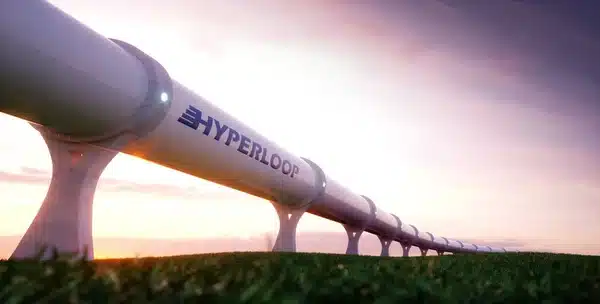Hyperloop technology is a high-speed transportation system that involves a network of sealed tubes or tunnels through which pods or capsules move at high speeds, reaching over 1000 km/h. This technology was first proposed by Elon Musk in 2013 and has since gained interest and investment from various companies and governments around the world.
Here is a beginner’s guide to Hyperloop technology:
- How does Hyperloop work?
Hyperloop works by using a combination of reduced air pressure and magnetic levitation (maglev) technology to move capsules or pods through tubes or tunnels. The reduced air pressure reduces air resistance, which allows the pods to move at high speeds with minimal energy consumption. The maglev technology helps to levitate the capsules, allowing them to move without friction.
- Benefits of Hyperloop
Hyperloop technology has the potential to revolutionize transportation by offering several benefits, including:
- High speeds: Hyperloop technology can enable travel speeds of over 1000 km/h, which is faster than most current transportation modes such as planes, trains, and cars.
- Energy-efficient: Hyperloop systems consume less energy than traditional transportation modes, making them more environmentally friendly.
- Reduced travel time: With faster travel speeds, Hyperloop technology can reduce travel times significantly, making it easier to travel long distances quickly.
- Safe and reliable: Hyperloop systems are designed to be safe and reliable, with advanced safety features such as emergency braking and redundant systems.
- Challenges and limitations of Hyperloop
Despite its potential benefits, Hyperloop technology also faces some challenges and limitations, including:
- High initial cost: Building a Hyperloop system requires significant investment, which may make it expensive to implement.
- Regulatory challenges: Hyperloop technology is a new and untested transportation system, which may face regulatory challenges and require extensive testing and safety certification.
- Technical challenges: The technology is still in its early stages, and several technical challenges need to be addressed before it can be implemented on a large scale.
- Limited capacity: Hyperloop systems may have limited capacity and may not be suitable for transporting large numbers of people or heavy cargo.
- Current state of Hyperloop technology
Several companies and governments around the world are currently working on developing and testing Hyperloop technology. Some of the notable companies in this space include Virgin Hyperloop, Hyperloop Transportation Technologies, and TransPod. However, despite progress in research and development, no fully operational Hyperloop system currently exists.
In conclusion, Hyperloop technology has the potential to revolutionize transportation by offering faster, energy-efficient, and safe travel. However, it also faces several challenges and limitations that need to be addressed before it can be implemented on a large scale.
- Components of a Hyperloop system
A Hyperloop system consists of three main components:
- Tubes or tunnels: The tubes or tunnels form the network through which the pods or capsules move. The tubes are sealed and have reduced air pressure to reduce air resistance.
- Capsules or pods: The capsules or pods carry passengers or cargo and move through the tubes using magnetic levitation technology.
- Propulsion system: The propulsion system provides the energy needed to move the capsules or pods through the tubes. It can be powered by electricity, solar energy, or other renewable sources.
- Hyperloop vs. other transportation modes
Hyperloop technology offers several advantages over traditional transportation modes such as planes, trains, and cars. Here are some comparisons:
- Speed: Hyperloop systems can travel at speeds of over 1000 km/h, which is faster than planes and trains.
- Energy efficiency: Hyperloop systems consume less energy than planes and cars, making them more environmentally friendly.
- Infrastructure: Hyperloop systems require less infrastructure than planes and trains, making them more cost-effective and easier to implement.
- Capacity: Hyperloop systems may have limited capacity compared to planes and trains, which can transport more people and cargo at once.
- Hyperloop projects around the world
Several companies and governments around the world are working on developing and testing Hyperloop technology. Here are some notable projects:
- Virgin Hyperloop: This company is working on developing a Hyperloop system in India, which would connect Mumbai and Pune, two major cities in the country.
- Hyperloop Transportation Technologies: This company is developing a Hyperloop system in Abu Dhabi, which would connect the city with Dubai.
- TransPod: This company is developing a Hyperloop system in Canada, which would connect Toronto and Montreal.
- Potential applications of Hyperloop technology
Hyperloop technology has several potential applications, including:
- Passenger transportation: Hyperloop systems could be used to transport passengers between cities, reducing travel time and making long-distance travel more convenient.
- Cargo transportation: Hyperloop systems could be used to transport cargo between cities, offering a faster and more efficient alternative to traditional transportation modes.
- Emergency response: Hyperloop systems could be used for emergency response, allowing first responders to quickly reach areas affected by natural disasters or other emergencies.
In summary, Hyperloop technology has the potential to revolutionize transportation by offering faster, more efficient, and more environmentally friendly travel. While it still faces challenges and limitations, ongoing research and development suggest that Hyperloop systems may become a reality in the not-too-distant future.






